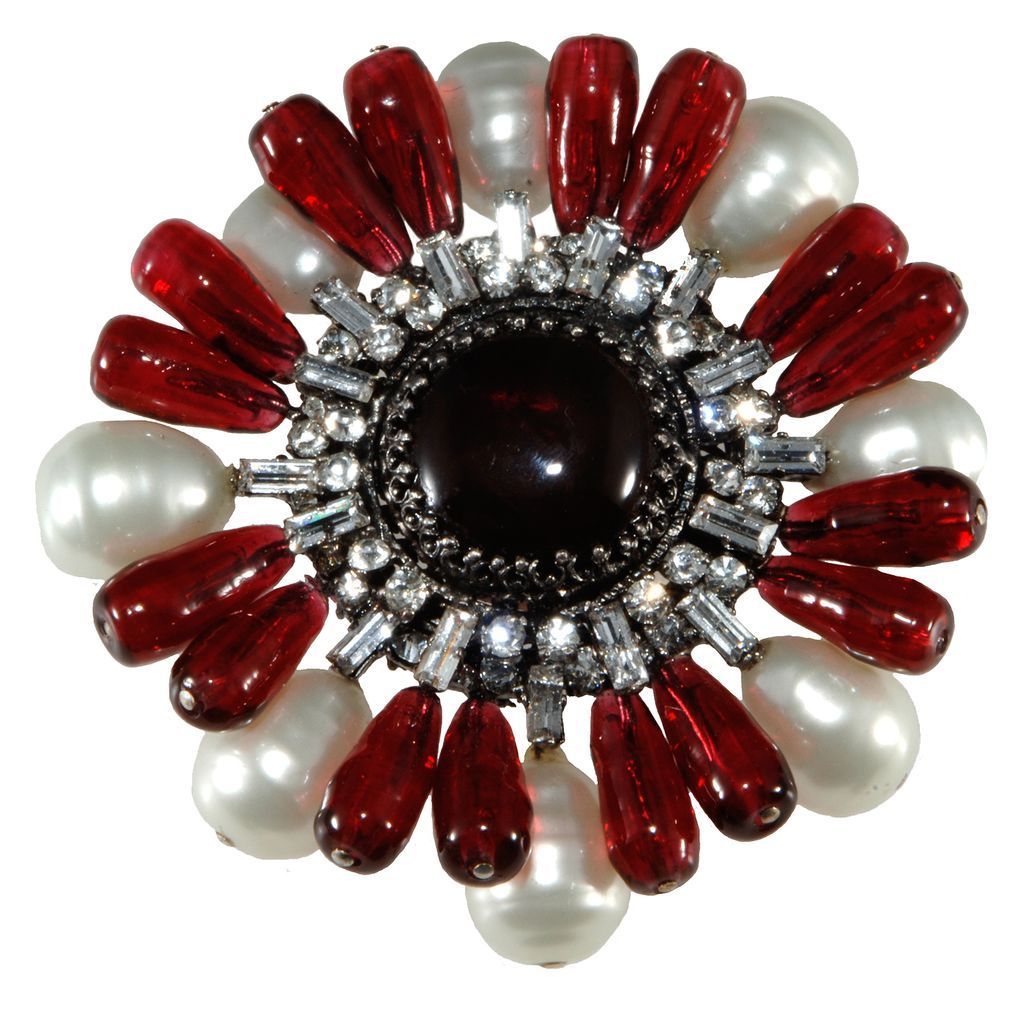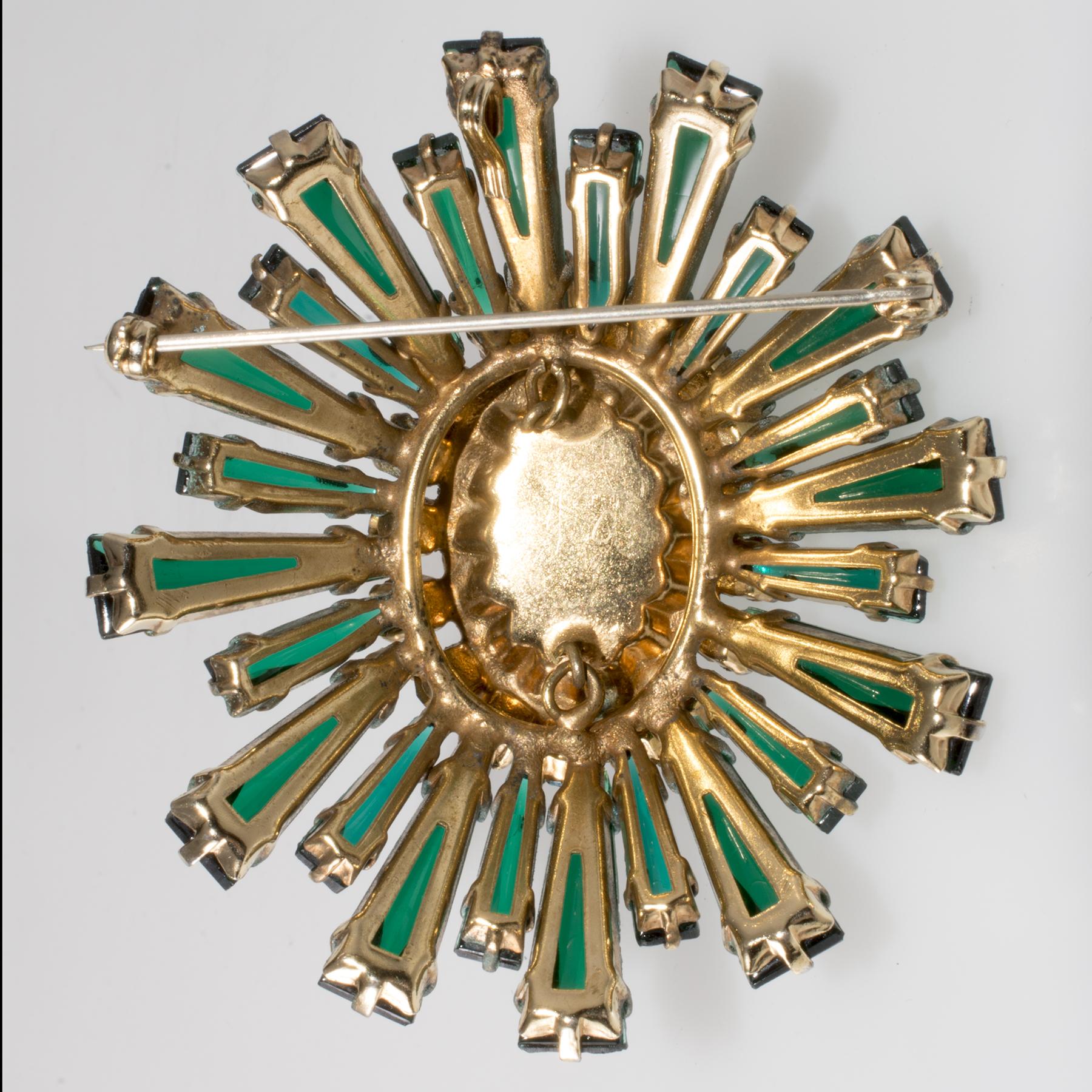
Costume Jewelry Collectors Int’l Hosts Sixth Annual Convention in Rhode Island
October 5, 2016
What is Gripoix and Poured Glass in Jewelry, and What Isn’t
July 30, 2018
An unmarked variation of the Schreiner "Ruffle" brooch made with the company's famed keyestone rhinestones. Photo by Jay B. Siegel for ChicAntiques.com
Schreiner of New York made many, many unmarked brooches. Some of these are quite easy to identify once you’ve handled marked versions simply because the same settings were used with different stone combinations, or in different colors. Other pieces are quite unique, but still have attributes of note that point to Schreiner.
Looking at as many signed Schreiner brooches as possible will be the first step in learning to identify unmarked pieces in the field. Studying the various attributes that were used again and again by this company provide useful clues. Some of the most common are listed below.
HOOK AND EYE CONSTRUCTION
One of the most obvious construction techniques Schreiner fans learn to look for is the “hook and eye” found by examining the backs of these pieces. They are often made in more than one part and linked together by a metal wire (the hook) that fits through a loop-shaped finding (the eye) to hold the layered components together. Not all Schreiner brooches were made this way, but many were.
Some also have rings to which the metal “hooks” are attached. These designs can be very similar in construction to pieces made by other manufacturers (the Canadian company Sherman for one), especially when domes of riveted rhinestones are present.
Keep in mind, however, that other jewelry manufacturers used similar techniques so once you notice the hook and eye by looking at the back, examine the piece further for more clues as noted below.

Schreiner brooch exhibiting inverted rhinestones and layered construction. Photo by Jay B. Siegel for ChicAntiques.com
INVERTED STONES
Collectors also look for inverted stones in Schreiner pieces (which should not be confused with rivoli stones or other stones with pointed tops). The inverted stones used in Schreiner jewelry are regular rhinestone shapes (round, pear, etc.) that are not foiled on the backs. They were placed in the stone cups upside down when the piece was made. This is actually one of the most common identifiers that sets Schreiner designs apart from those made by other manufacturers of vintage jewelry.
Again, occasionally other jewelry manufacturers employed this technique so you must be mindful that not every piece with inverted stones is Schreiner. Look for additional attributes before assuming a piece with inverted stones is Schreiner. This is just one identifying factor.

Unmarked Schreiner butterfly brooch (with detachable rhinestone neck chain) made with dogtooth prongs surrounding the large oval stones. Photo by Jay B. Siegel for ChicAntiques.com
DOGTOOTH PRONGS AND CRIMPED STONE CUPS
Schreiner also used dogtooth prongs and crimped stone cups in many of their designs, but it’s important to realize that many other companies did as well.
Once again, if you see dogtooth prongs and/or crimped stone cups, look for hook and eye construction, inverted stones, familiar designs, and other clues linking an unmarked brooch to a possible Schreiner attribution identifying factor.
SPECIALTY STONES
This company is also known for its incredibly beautiful art glass and specialty stones along with high-quality glass pearls in intricately crafted pieces. Some stones, like their large keystones found in highly coveted “ruffle” brooches were commissioned exclusively for Schreiner. Other stones they used in their designs were made in very limited quantities, so you will not see them over and over again. A number of those types of stones required special settings to be made to hold them.
Some Schreiner pieces simply hint to toward the manufacturer, like the brooch shown here with unusual central stones surrounded by milky white and clear accents. There are no inverted rhinestones. Hook and eye construction is not present. But those large, unique stones along with the open stone cups viewed from the back and the way the brooch is plated do point to Schreiner. Having a confirmation from Stephen Albert, whose father Ambros worked for Schreiner and contributed to Schreiner: Masters of Twentieth Century Costume Jewelry by Carole Tanenbaum and Eve Townsend, completes the Schreiner attribution.
“Handmade settings are a trademark of my dad. My grandfather bought out a lot of shops stone inventories, in the 30s, that were going out of business in Rhode Island. A lot of the stones were very limited amounts of odd lots of stones. Most did not fit standard settings, and were too small of an amount to have settings manufactured, so my dad, Ambrose, figured out how to make handmade, or modify available settings [like this one]. Since these are custom made in small quantities, pieces with handmade settings, and odd lot stones, are the most rare Schreiner items on the market,” Albert shared with Pamela Wiggins Siegel.

Back of Schreiner brooch with large unmarked specialty stones in a handmade setting. Photo by Jay B. Siegel for ChicAntiques.com
RECURRING SETTINGS
Once you start examining Schreiner pieces, you’ll find that they skillfully used the same settings again and again in a number of instances. But instead of making the same exact brooch, they changed the colors and/or stone shapes used to completely transform the look. This was done with everything from the desirable “ruffle” brooches to more common designs found fairly frequently by collectors.
Several designs that were made both marked and unmarked are “collage” pieces. That is, they use a variety of different shapes and sizes of stones to craft a unique piece. Lots of manufacturers employed this technique in their craftsmanship though, so be sure you’re matching up your collage brooches to known Schreiner styles (those that have been verified with marked pieces like the examples here).

Back of Schreiner brooches using the same setting style in four different ways. Photo by Jay B. Siegel for Warman's Costume Jewelry

A grouping of four large Schreiner brooches using the same setting with different stones and colors. Only the amber brooch is marked Schreiner. Photo by Jay B. Siegel for Warman's Costume Jewelry
So, while you can certainly learn to skillfully recognize unsigned brooches as Schreiner, it is important to bear in mind that no single characteristic makes an attribution. You must look at the entire piece as a whole, as well as examining individual components, when evaluating this jewelry to avoid confusing it with other types made in Austria and those by DeLizza & Elster (also known as “Juliana” by collectors), Sherman, and other well-known vintage costume jewelry brands.
Recommended Book Resource:
Schreiner: Masters of Twentieth-Century Costume Jewelry by Carole Tanenbaum and Eve Townsend (Paid Link)
Pamela Wiggins Siegel is the author of Warman’s Costume Jewelry, which includes additional information on identifying unmarked Schreiner jewelry.






